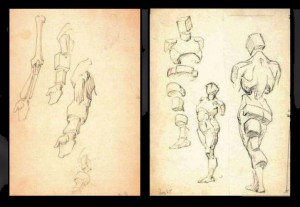Stockbridge, MA, June 17, 2013—Norman Rockwell Museum announces the conservation and return to its American Illustration Collection of 28 rare drawings on paper by renowned anatomy and figure-drawing teacher and illustrator George Bridgman (1864-1943). Th

Two of 28 conserved anatomical drawings by artist George Bridgman from Norman Rockwell Museum’s permanent collection. Courtesy Norman Rockwell Museum. All rights reserved.
e damaged drawings were taken to Williamstown Art Conservation Center (WACC) in nearby Williamstown, MA, where they received treatment in 2012 and 2013 under a generous grant from the federal Institute of Museum and Library Services (IMLS). WACC is the largest regional conservation center in the United States, housed in the Sterling and Francine Clark Art Institute’s Stone Hill Center.
The 28 drawings are part of a larger gift of more than 100 Bridgman study drawings that had been donated to the Museum in 2010. Anticipating their return, the Museum purchased a state-of-the-art Staba Arte flat-file cabinet to re-house and protect all the drawings. With the return of the treated drawings, the entire Bridgman collection is now available to researchers and curators who wish to include them in future exhibitions.
In the context of American art history, the Bridgman collection has great historic and artistic importance. One of the great anatomists of the last century, Bridgman’s influence on 20th century American art – from illustration and commercial imagery to abstract expressionism and post-modernism – is deep. He is best known for his popular life drawing and anatomy books that are still used today.
Studying under Jean-Lêon Gérômé (1824-1904) at the École des Beaux-Arts and later with Parisian figure painter Gustave Boulanger (1824-1888), Bridgman established a unique technique for capturing human anatomy, gesture, and details by representing parts of the body as geometric forms. As an instructor at the Art Students League in New York for 45 years, he taught nearly 70,000 students – many who would go on to become some of our most significant artists. Among them were sculptor Paul Manship (best known for the statue Prometheus at Rockefeller Center), painter-muralist Gifford Beal, comic creator Will Eisner, illustrator Edmund F. Ward, illustrator Andrew Loomis, artist/teacher Kimon Nicolaides (known for his widely-used book, “The Natural Way to Draw”), abstractionist Arshile Gorky, abstract expressionist Jackson Pollack, Peter Max, and Norman Rockwell.
Bridgman was an inspiring presence for the young Rockwell, who began his studies at the Art League in 1911 and spoke highly of him in his 1960 autobiography, “My Adventures as an Illustrator.” “We worshipped George Bridgman,” Rockwell wrote.
The Bridgman drawings had not been easily accessible to researchers for decades, nor have they been presented in public exhibitions. Prior to their transfer to Norman Rockwell Museum, all the drawings had been rolled and stored in tubes in an attic-space for more than 75 years. Museum staff carefully unrolled the drawings to allow an onsite inspection by WACC. 28 were selected for immediate treatment – with the four largest needing “urgent” treatment due to their fragile condition. These were sent to Williamstown in July 2012, and the last of the treated drawings were returned to the Museum in April 2013.
The treated drawings – along with the entire Bridgman collection – provide scholars and curators with an unparalleled resource on how Bridgman constructed his lessons and taught figure drawing in the classroom and through his books.

